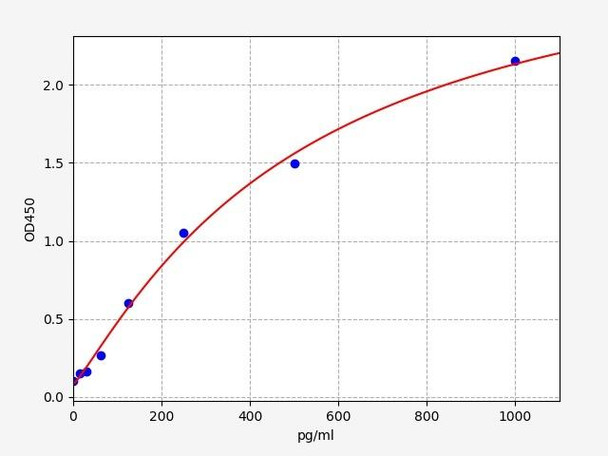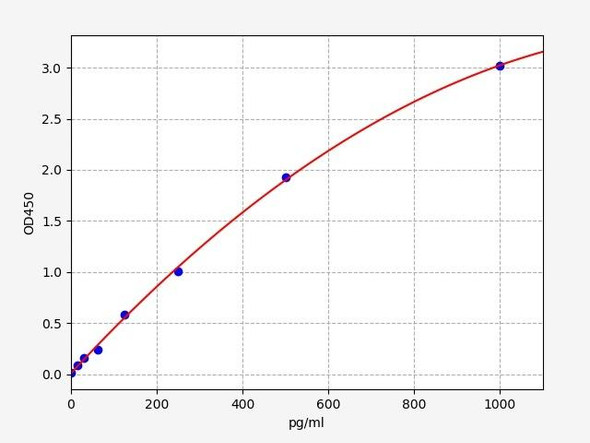Rat TNF-Alpha (Tumor Necrosis Factor Alpha) ELISA Kit
- SKU:
- RTFI01177
- Product Type:
- ELISA Kit
- Size:
- 96 Assays
- Uniprot:
- P16599
- Sensitivity:
- 9.375pg/ml
- Range:
- 15.625-1000pg/ml
- ELISA Type:
- Sandwich ELISA, Double Antibody
- Synonyms:
- TNF-alpha, DIF, TNF-alpha, TNFA, TNFSF2
- Reactivity:
- Rat
Description
| Product Name: | Rat TNF-alpha (Tumor Necrosis Factor Alpha) ELISA Kit |
| Product Code: | RTFI01177 |
| Size: | 96 Assays |
| Target: | Rat TNF-alpha |
| Alias: | TNF-alpha, DIF, TNF-alpha, TNFA, TNFSF2 |
| Reactivity: | Rat |
| Detection Method: | Sandwich ELISA, Double Antibody |
| Sensitivity: | 9.375pg/ml |
| Range: | 15.625-1000pg/ml |
| Storage: | 4°C for 6 months |
| Note: | For Research Use Only |
| Recovery: | Matrices listed below were spiked with certain level of Rat TNF-alpha and the recovery rates were calculated by comparing the measured value to the expected amount of Rat TNF-alpha in samples. | ||||||||||||||||
| |||||||||||||||||
| Linearity: | |||||||||||||||||
| |||||||||||||||||
| Intra-Assay: | CV <8% | ||||||||||||||||
| Inter-Assay: | CV <10% |
| Uniprot: | P16599 |
| UniProt Protein Function: | TNF-a: Cytokine that binds to TNFRSF1A/TNFR1 and TNFRSF1B/TNFBR. It is mainly secreted by macrophages and can induce cell death of certain tumor cell lines. It is potent pyrogen causing fever by direct action or by stimulation of interleukin-1 secretion and is implicated in the induction of cachexia, Under certain conditions it can stimulate cell proliferation and induce cell differentiation. Homotrimer. Interacts with SPPL2B. Belongs to the tumor necrosis factor family. |
| UniProt Protein Details: | Protein type:Motility/polarity/chemotaxis; Membrane protein, integral; Cytokine; Apoptosis Cellular Component: extracellular space; recycling endosome; cell surface; integral to plasma membrane; integral to membrane; plasma membrane; intracellular; external side of plasma membrane; phagocytic cup; lipid raft Molecular Function:identical protein binding; protease binding; cytokine activity; tumor necrosis factor receptor binding Biological Process: extracellular matrix organization and biogenesis; positive regulation of nitric oxide biosynthetic process; positive regulation of NFAT protein import into nucleus; activation of MAPK activity; positive regulation of apoptosis; positive regulation of transcription, DNA-dependent; positive regulation of caspase activity; positive regulation of translational initiation by iron; positive regulation of membrane protein ectodomain proteolysis; activation of NF-kappaB transcription factor; positive regulation of MAP kinase activity; cellular extravasation; tumor necrosis factor-mediated signaling pathway; positive regulation of phagocytosis; negative regulation of interleukin-6 production; JNK cascade; negative regulation of osteoblast differentiation; positive regulation of action potential; embryonic gut development; negative regulation of protein complex disassembly; response to drug; positive regulation of cytokine production; positive regulation of heterotypic cell-cell adhesion; positive regulation of mitosis; response to virus; positive regulation of interleukin-6 production; glucose metabolic process; negative regulation of cytokine secretion during immune response; positive regulation of protein transport; DNA damage response, signal transduction resulting in induction of apoptosis; response to mechanical stimulus; defense response to bacterium; positive regulation of transcription from RNA polymerase II promoter; skeletal muscle contraction; sequestering of triacylglycerol; positive regulation of JNK cascade; negative regulation of transcription from RNA polymerase II promoter; signal transduction; positive regulation of interleukin-18 production; chronic inflammatory response to antigenic stimulus; positive regulation of hair follicle development; negative regulation of cell proliferation; positive regulation of neuron apoptosis; protein kinase B signaling cascade; positive regulation of chronic inflammatory response to antigenic stimulus; inflammatory response; regulation of protein amino acid phosphorylation; transformed cell apoptosis; positive regulation of peptidyl-serine phosphorylation; humoral immune response; regulation of cell proliferation; positive regulation of protein kinase B signaling cascade; positive regulation of interferon-gamma production; positive regulation of programmed cell death; positive regulation of protein complex assembly; negative regulation of viral genome replication; response to hypoxia; regulation of insulin secretion; positive regulation of JNK activity; positive regulation of osteoclast differentiation; multicellular organismal development; response to glucocorticoid stimulus; response to lipopolysaccharide; positive regulation of NF-kappaB import into nucleus; osteoclast differentiation; regulation of immunoglobulin secretion; positive regulation of I-kappaB kinase/NF-kappaB cascade; positive regulation of interleukin-8 biosynthetic process; positive regulation of chemokine production; cell activation; detection of mechanical stimulus involved in sensory perception of pain; organ morphogenesis; defense response to Gram-positive bacterium; induction of apoptosis via death domain receptors; positive regulation of transcription factor activity; negative regulation of L-glutamate transport; response to activity; negative regulation of transcription, DNA-dependent; leukocyte migration; apoptosis; positive regulation of smooth muscle cell proliferation; defense response; positive regulation of synaptic transmission; response to radiation; regulation of protein secretion; regulation of osteoclast differentiation; negative regulation of lipid catabolic process; lipopolysaccharide-mediated signaling pathway; regulation of I-kappaB kinase/NF-kappaB cascade; caspase activation; positive regulation of humoral immune response mediated by circulating immunoglobulin; positive regulation of protein complex disassembly; calcium-mediated signaling; MAPKKK cascade; negative regulation of glucose import; positive regulation of chemokine biosynthetic process; protein import into nucleus, translocation; positive regulation of protein kinase activity; positive regulation of fever; activation of MAPKKK activity; positive regulation of protein amino acid phosphorylation; receptor biosynthetic process; leukocyte tethering or rolling; negative regulation of myoblast differentiation; positive regulation of inflammatory response; positive regulation of cytokine secretion |
| NCBI Summary: | acts as a cytokine; binds TNF receptors; plays a role in regulation of cell proliferation, induction of apoptosis, and inflammatory response [RGD, Feb 2006] |
| UniProt Code: | P16599 |
| NCBI GenInfo Identifier: | 135938 |
| NCBI Gene ID: | 24835 |
| NCBI Accession: | P16599.1 |
| UniProt Secondary Accession: | P16599,Q6EE11, Q9JI26, Q9JI27, |
| UniProt Related Accession: | P16599 |
| Molecular Weight: | 25,806 Da |
| NCBI Full Name: | Tumor necrosis factor |
| NCBI Synonym Full Names: | tumor necrosis factor |
| NCBI Official Symbol: | Tnf |
| NCBI Official Synonym Symbols: | Tnfa; RATTNF; TNF-alpha |
| NCBI Protein Information: | tumor necrosis factor; cachectin; tumor necrosis factor alpha; tumor necrosis factor (TNF superfamily, member 2); tumor necrosis factor ligand superfamily member 2 |
| UniProt Protein Name: | Tumor necrosis factor |
| UniProt Synonym Protein Names: | Cachectin; TNF-alpha; Tumor necrosis factor ligand superfamily member 2; TNF-a |
| Protein Family: | Tumor necrosis factor |
| UniProt Gene Name: | Tnf |
| UniProt Entry Name: | TNFA_RAT |
| Step | Procedure |
| 1. | Set standard, test sample and control (zero) wells on the pre-coated plate respectively, and then, record their positions. It is recommended to measure each standard and sample in duplicate. Wash plate 2 times before adding standard, sample and control (zero) wells! |
| 2. | Aliquot 0.1ml standard solutions into the standard wells. |
| 3. | Add 0.1 ml of Sample / Standard dilution buffer into the control (zero) well. |
| 4. | Add 0.1 ml of properly diluted sample ( Human serum, plasma, tissue homogenates and other biological fluids.) into test sample wells. |
| 5. | Seal the plate with a cover and incubate at 37°C for 90 min. |
| 6. | Remove the cover and discard the plate content, clap the plate on the absorbent filter papers or other absorbent material. Do NOT let the wells completely dry at any time. Wash plate X2. |
| 7. | Add 0.1 ml of Biotin- detection antibody working solution into the above wells (standard, test sample & zero wells). Add the solution at the bottom of each well without touching the side wall. |
| 8. | Seal the plate with a cover and incubate at 37°C for 60 min. |
| 9. | Remove the cover, and wash plate 3 times with Wash buffer. Let wash buffer rest in wells for 1 min between each wash. |
| 10. | Add 0.1 ml of SABC working solution into each well, cover the plate and incubate at 37°C for 30 min. |
| 11. | Remove the cover and wash plate 5 times with Wash buffer, and each time let the wash buffer stay in the wells for 1-2 min. |
| 12. | Add 90 µL of TMB substrate into each well, cover the plate and incubate at 37°C in dark within 10-20 min. (Note: This incubation time is for reference use only, the optimal time should be determined by end user.) And the shades of blue can be seen in the first 3-4 wells (with most concentrated standard solutions), the other wells show no obvious color. |
| 13. | Add 50 µL of Stop solution into each well and mix thoroughly. The color changes into yellow immediately. |
| 14. | Read the O.D. absorbance at 450 nm in a microplate reader immediately after adding the stop solution. |
When carrying out an ELISA assay it is important to prepare your samples in order to achieve the best possible results. Below we have a list of procedures for the preparation of samples for different sample types.
| Sample Type | Protocol |
| Serum: | If using serum separator tubes, allow samples to clot for 30 minutes at room temperature. Centrifuge for 10 minutes at 1,000x g. Collect the serum fraction and assay promptly or aliquot and store the samples at -80°C. Avoid multiple freeze-thaw cycles. If serum separator tubes are not being used, allow samples to clotovernight at 2-8°C. Centrifuge for 10 minutes at 1,000x g. Removeserum and assay promptly or aliquot and store the samples at-80°C. Avoid multiple freeze-thaw cycles. |
| Plasma: | Collect plasma using EDTA or heparin as an anti-coagulant. Centrifuge samples at 4°C for 15 mins at 1000 — g within 30 mins of collection. Collect the plasma fraction and assay promptly or aliquot and store the samples at -80°C. Avoid multiple freeze-thaw cycles.Note: Over haemolysed samples are not suitable for use with this kit. |
| Urine & Cerebrospinal Fluid: | Collect the urine (mid-stream) in a sterile container, centrifuge for 20 mins at 2000-3000 rpm. Remove supernatant and assay immediately. If any precipitation is detected, repeat the centrifugation step. A similar protocol can be used for cerebrospinal fluid. |
| Cell Culture Supernatant: | Collect the cell culture media by pipette, followed by centrifugation at 4°C for 20 mins at 1500 rpm. Collect the clear supernatant and assay immediately. |
| Cell Lysates: | Solubilize cells in lysis buffer and allow to sit on ice for 30 minutes. Centrifuge tubes at 14,000 x g for 5 minutes to remove insoluble material. Aliquot the supernatant into a new tube and discard the remaining whole cell extract. Quantify total protein concentration using a total protein assay. Assay immediately or aliquot and store at ≤ -20°C. |
| Tissue Homogenates: | The preparation of tissue homogenates will vary depending upon tissue type. Rinse tissue with 1X PBS to remove excess blood & homogenizein 20ml of 1X PBS (including protease inhibitors) and store overnight at ≤ -20°C. Two freeze-thaw cycles are required to break the cell membranes. To further disrupt the cell membranes you can sonicate the samples. Centrifuge homogenates for 5 mins at 5000xg. Remove the supernatant and assay immediately or aliquot and store at -20°C or-80°C. |
| Tissue Lysates: | Rinse tissue with PBS, cut into 1-2 mm pieces, and homogenize with a tissue homogenizer in PBS. Add an equal volume of RIPA buffer containing protease inhibitors and lyse tissues at room temperature for 30 minutes with gentle agitation. Centrifuge to remove debris. Quantify total protein concentration using a total protein assay. Assay immediately or aliquot and store at ≤ -20 °C. |
| Breast Milk: | Collect milk samples and centrifuge at 10,000 x g for 60 min at 4°C. Aliquot the supernatant and assay. For long term use, store samples at -80°C. Minimize freeze/thaw cycles. |
| Chen et al. | HBO-PC Promotes Locomotor Recovery by Reducing Apoptosis and Inflammation in SCI Rats: The Role of the mTOR Signaling Pathway | Cell Mol Neurobiol. (2020) | PubMed: 32715402 |








